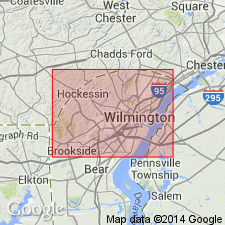
- Usage in publication:
-
- Brandywine Blue Gneiss
- Modifications:
-
- Original reference
- Dominant lithology:
-
- Gneiss
- AAPG geologic province:
-
- Piedmont-Blue Ridge province
Summary:
Pg. 17-18; W.S. Schenck and others, 2000, Delaware Geol. Survey, Geol. Map. Ser., no. 10, scale 1:36,000. Brandywine Blue Gneiss of Wilmington Complex. Referred to as Brandywine blue granite by early stone cutters and local geologists. To retain the local usage and priority of previous names, it is herein formally named Brandywine Blue Gneiss. Probably named from Brandywine Creek. Consists of medium- to coarse-grained granulites and gneisses. Has a distinctive bright blue to blue-gray color. Major minerals are plagioclase, quartz, orthopyroxene, clinopyroxene, brown-green hornblende, magnetite, and ilmenite. Contains thin, discontinuous fine-grained mafic layers. Is in contact with Wissahickon Formation, and Faulkland Gneiss and Arden Plutonic Supersuite of Wilmington Complex. Igneous zircons from a sample of felsic gneiss (locality Bd42-e) yielded a U-Pb age of 476 +/-6 Ma (J.N. Aleinikoff, USGS, personal commun., 2000). [Age is considered Early Ordovician; the Early/Middle Ordovician boundary is approx. 470 Ma.] Grauert and Wagner, 1975 (Amer. Jour. Sci., v. 275, p. 683-691) obtained a U-Pb zircon age of 441 Ma and interpreted it to be the age of the granulite-facies metamorphism.
Type section: in large quarries along the northeast side of Brandywine Creek, adjacent to the Northern Delaware Greenway, Alapocas Woods Park, Lat. 39 deg. 46 min. 10 sec. N., Long. 75 deg. 33 min. 37 sec. W., Wilmington North 7.5-min quadrangle, New Castle Co., DE.
Source: Publication.
For more information, please contact Nancy Stamm, Geologic Names Committee Secretary.
Asterisk (*) indicates published by U.S. Geological Survey authors.
"No current usage" (†) implies that a name has been abandoned or has fallen into disuse. Former usage and, if known, replacement name given in parentheses ( ).
Slash (/) indicates name conflicts with nomenclatural guidelines (CSN, 1933; ACSN, 1961, 1970; NACSN, 1983, 2005, 2021). May be explained within brackets ([ ]).

